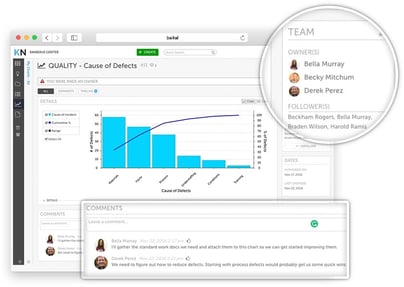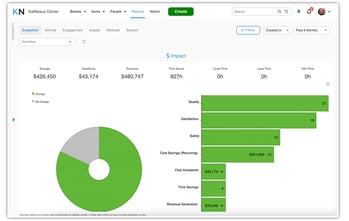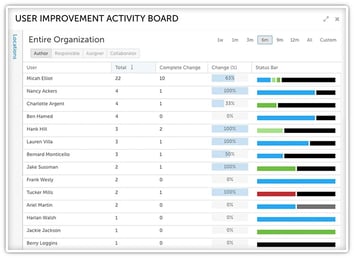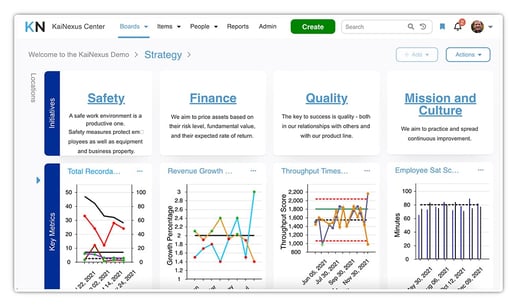 Given the nature of our business, you can probably imagine that we get the chance to talk to lots of folks who are struggling to create a culture of improvement that lasts.
Given the nature of our business, you can probably imagine that we get the chance to talk to lots of folks who are struggling to create a culture of improvement that lasts.
One of the most common emotions that these leaders express is frustration. It’s fairly obvious that improvement is good for everyone in the organization. “Why doesn’t it just happen on its own, or with some support from management?” they ask.
Our experience with clients over the years has taught us that there are some barriers that get in the way of positive change. The good news is that CQI software can help break them down.
Leaders, Managers, and Employees Alike are Hampered by a Lack of Visibility
“Improvement” can take many forms, happen at every level of the org chart, and involve everyone in the company. That makes the health of improvement culture and progress toward improvement goals difficult for everyone to track. Without technology in place to capture what is happening, it can be impossible to know who is working on what at any given moment. CQI software addresses this problem by creating a central repository for all improvement-related activities, goals, and documents. The best solutions allow users to create dashboards, allowing for visual management and instant understanding of the current state of improvement activities.
Cross-functional Collaboration is a Difficult Challenge
 There’s something ironic about cross-functional collaboration when it comes to improvement. Improvement projects that require the input and efforts of people from different functional areas are generally the most difficult ones to complete, but they are often (by far) the most impactful. That’s because the moments when work in progress is handed off from one team to another are typically prone to error and inefficiency. If you are looking for waste or a place to start your improvement initiative, start there. CQI software makes cross-functional collaboration easier by providing everyone with all of the information and assets they need to work together. All activities are tracked in one place and everyone working on the project can add notes, documents, or other useful information. It helps ensure that everyone speaks the same language and ends the practice of working in silos.
There’s something ironic about cross-functional collaboration when it comes to improvement. Improvement projects that require the input and efforts of people from different functional areas are generally the most difficult ones to complete, but they are often (by far) the most impactful. That’s because the moments when work in progress is handed off from one team to another are typically prone to error and inefficiency. If you are looking for waste or a place to start your improvement initiative, start there. CQI software makes cross-functional collaboration easier by providing everyone with all of the information and assets they need to work together. All activities are tracked in one place and everyone working on the project can add notes, documents, or other useful information. It helps ensure that everyone speaks the same language and ends the practice of working in silos.
It is Difficult to Advocate for Improvement if You Can’t Quantify the Results
 One of the most common problems we see in organizations that try to practice continuous improvement without technology to support it is that they can’t say whether their improvement work is resulting in better business performance. They may feel like a process is more efficient, for example, but find it difficult to quantify exactly what that means.
One of the most common problems we see in organizations that try to practice continuous improvement without technology to support it is that they can’t say whether their improvement work is resulting in better business performance. They may feel like a process is more efficient, for example, but find it difficult to quantify exactly what that means.
CQI software provides a platform for impact measurement. Improvements may be measured in terms of reduced cost, faster cycle times, fewer errors, improved customer satisfaction, or any other metric that is important to your business.
When leaders can point to concrete results (especially financial ones), they are in a better position to request more resources for improvement work.
Employee Engagement is Not a Given
 Organizations that operate a successful culture of improvement involve every person in the organization in the work. They practice both top-down and bottom-up improvement, with everyone encouraged to identify ways to make processes work better. But that sort of culture doesn’t just pop up on its own. Leaders must work hard to demonstrate that improvement work is central to the success of the organization.
Organizations that operate a successful culture of improvement involve every person in the organization in the work. They practice both top-down and bottom-up improvement, with everyone encouraged to identify ways to make processes work better. But that sort of culture doesn’t just pop up on its own. Leaders must work hard to demonstrate that improvement work is central to the success of the organization.
Investing in CQI software is one way to signal management’s commitment to the approach.
The impact reporting we mentioned before is also important in terms of employee engagement. When people see the gains, they are more motivated to participate in improvement work and more vigilant about identifying opportunities for change.
Company Strategy and Goals Are Not Clear
 While everything that can be improved should be improved, it is important to prioritize improvements that require resources and to ensure that improvement work is impacting the overall company strategy and most important goals. CQI software allows leaders to align company, department, team, and individual goals so that everyone is pulling in the same direction. It increases the visibility of the key performance indicators that are used to measure progress. Everyone gets a clear vision of how they work they do impacts the mission, increasing engagement even further.
While everything that can be improved should be improved, it is important to prioritize improvements that require resources and to ensure that improvement work is impacting the overall company strategy and most important goals. CQI software allows leaders to align company, department, team, and individual goals so that everyone is pulling in the same direction. It increases the visibility of the key performance indicators that are used to measure progress. Everyone gets a clear vision of how they work they do impacts the mission, increasing engagement even further.
CQI software is not a silver bullet.
It won’t make up for a lack of executive interest in improvement or a lack of recognition for employees who contribute to positive change.
But with the right attitude and commitment, it does a lot to address the most common challenges, streamline projects, and encourage wide participation. If you want your continuous quality improvement program to fire on all cylinders, it’s something to seriously consider.



Add a Comment